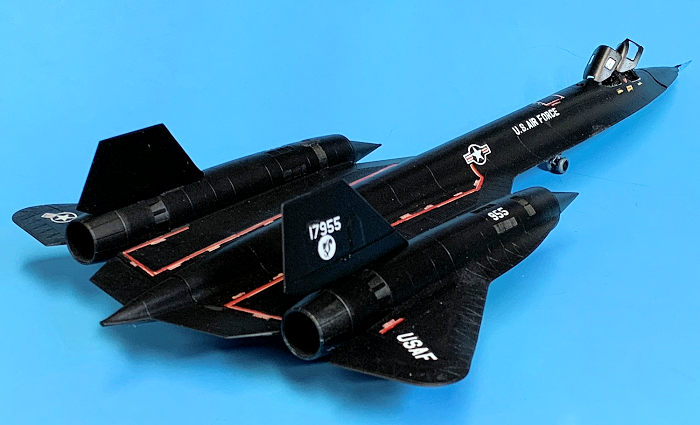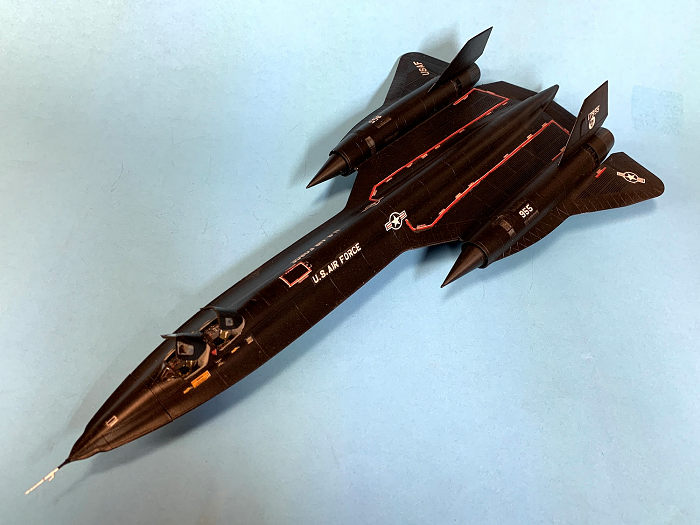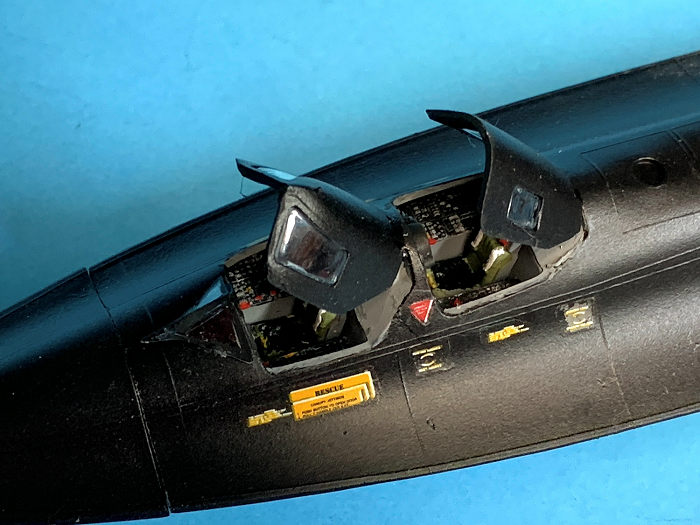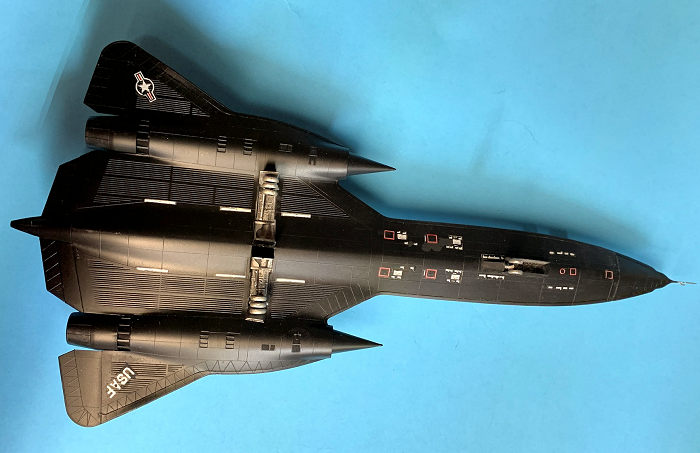
Monogram 1/72 SR-71 Blackbird
| KIT #: | 5810 |
| PRICE: | $18-30 'used' |
| DECALS: | Two options |
| REVIEWER: | Blair Stewart |
| NOTES: | Good cockpit and gear well detail |

| HISTORY |
The Lockheed SR-71 "Blackbird" is a retired long-range, high-altitude, Mach 3+ strategic reconnaissance aircraft developed and manufactured by the American aerospace company Lockheed Corporation. The SR-71 has several nicknames, including "Blackbird" and "Habu".
According to Lockheed-Martin, the SR-71 was developed as a replacement for the U-2 after Gary Powers’ U-2 aircraft was shot down over the Soviet Union in May 1960. Hit by Soviet surface-to-air missiles, the plane fell from 70,000 feet to 30,000 feet before Powers could release himself and bail out of the damaged cockpit.
The Skunk Works at Lockheed’s advanced development group in Burbank, CA, had already begun work on an innovative aircraft to improve intelligence-gathering, one that would fly faster than any aircraft before or since, at greater altitude, and with a minimal radar cross section. President Eisenhower deeply valued the strategic benefits of the U-2’s airborne reconnaissance during these tense Cold War times. And now the call came from Lockheed’s customer in Washington to build the impossible – an aircraft that can’t be shot down – and do it fast.
 Kelly
Johnson, one of the preeminent aircraft designers of the twentieth century, and
his Skunk Works team had a track record of delivering “impossible” technologies
on incredibly short, strategically critical deadlines. The U-2 was but one
example. The group was known for its unfailing sense of duty, its
creativity in the face of a technological challenge and its undaunted
perseverance.
Kelly
Johnson, one of the preeminent aircraft designers of the twentieth century, and
his Skunk Works team had a track record of delivering “impossible” technologies
on incredibly short, strategically critical deadlines. The U-2 was but one
example. The group was known for its unfailing sense of duty, its
creativity in the face of a technological challenge and its undaunted
perseverance.
This new aircraft was in a different category from anything that had come before. “Everything had to be invented. Everything,” Johnson recalled. He committed Skunk Works to succeed in its toughest assignment to date: to have the innovative, challenging, envelope-breaking aircraft flying in a mere twenty months.
Lockheed's Skunk Works division developed the SR-71 as a black project from the Lockheed A-12 program. The shape of the SR-71 was based on the A-12, which was the predecessor to the YF-12, a two-seat interceptor. The A-12 was one of the first aircraft to be designed with a reduced radar cross-section (i.e., “stealth”). The SR-71 was longer and heavier than the A-12, allowing it to hold more fuel as well as a two-seat cockpit. The SR-71's existence was revealed to the public in July 1964; it entered service in the United States Air Force (USAF) in January 1966.
The speed of the new aircraft was to exceed 2,000 mph. Other aircraft of the era could, in theory, approximate that speed but only in short, after-burner-driven bursts. This new airplane needed to maintain a record-setting speed for hours at a time. At such velocity, friction with the atmosphere generates temperatures that would melt a conventional airframe.
With anticipated temperatures on the aircraft’s leading edges exceeding 1,000 degrees Fahrenheit, dealing with the heat raised a host of seemingly insurmountable design and material challenges. Titanium alloy was the only option for the airframe —providing the strength of stainless steel, a relatively light weight, and durability at the excessive temperatures.
Titanium, however, proved to be a particularly sensitive material from which to build an airplane. The brittle alloy shattered if mishandled, which meant great frustration on the Skunk Works assembly line, and new training classes for Lockheed’s machinists. Conventional cadmium-plated steel tools, it was soon learned, embrittled the titanium on contact; so new tools were designed and fabricated—out of titanium.
A little-known fact is how the US got enough titanium to build the SR-71. Along with the material being difficult to work with, titanium was also hard to find. The US didn’t have the ore necessary to produce it. The biggest producer of the material was the Soviet Union. At the time, both countries were in the middle of the Cold War, and the US government didn’t want to give the Soviets any hints as to what they were up to.
 Col. Rich
Graham, an SR-71 pilot and former wing commander, explained what happened:
Col. Rich
Graham, an SR-71 pilot and former wing commander, explained what happened:
“The airplane is [92 percent] titanium inside and out. Back when they were building the airplane the United States didn’t have the ore supplies – an ore called rutile ore. It’s a very sandy soil and it’s only found in very few parts of the world. The major supplier of the ore was the USSR. Working through Third World countries and bogus operations, they were able to get the rutile ore shipped to the United States to build the SR-71.”
While friction would generate incredible heat at the leading edges of the aircraft, the ambient temperature outside the cockpit window would be -60 degrees Fahrenheit. Skunk Works’ Ben Rich spent untold hours tackling the problem of how heat could be dissipated across the entire airframe. Then he recalled a simple lesson from one of his university courses: Black paint both emits and absorbs heat. The aircraft was painted black, and soon earned its name: “Blackbird.”
Mission equipment for the plane's aerial reconnaissance role included signals intelligence sensors, side looking airborne radar, and a camera. During missions, the SR-71 operated at high speeds and altitudes (Mach 3.2 and 85,000 ft; 26,000 m), allowing it to outrace or entirely avoid threats. If a surface-to-air missile launch was detected, the standard evasive action was simply to accelerate and outpace the missile. On average, each SR-71 could fly once per week due to the extended turnaround required after mission recovery. A total of 32 aircraft were built; 12 were lost in accidents with none lost to enemy action.
Piloting the Blackbird was an unforgiving endeavor, demanding total concentration, but totally rewarding according to those who flew it:
At 85,000 feet and Mach 3, it was almost a religious experience,” said Air Force Colonel Jim Wadkins. “Nothing had prepared me to fly that fast… My God, even now, I get goose bumps remembering.”
(Note: retired USAF Major Brian Shul spent many years traveling around the country relating his experiences flying the SR-71. For a great story, search YouTube for the “LA Speed Story,” a humorous event where Brian and his SRO Walter Watson one-upped a Navy F-18 pilot’s request for a “ground speed check” from air traffic controllers at LA Center).
At Mach 3+ and 85,000 feet, even the best air defense systems had no hope of catching the Blackbird. When anti-aircraft weapons were fired, a warning light glowed red on the control panel. But that would typically be the last the pilot would see of the attempted attack, as surface-to-air missiles consistently missed wildly, exploding many miles from the intended target.
The Lockheed D-21 Unmanned Aerial Vehicle (UAV) was developed to undertake reconnaissance missions at Mach 3+ after being launched from an M-21, a variant of the A-12. Its first powered flight was in 1966. However, only a few missions were flown using the M-21 carrier aircraft because of a fatal accident that occurred when a D-21 impacted with an M-21 after a launch. Later D-21 flights were accomplished using a B-52 as a carrier aircraft.
The SR-71 set many records: it was and remains the world’s fastest and highest-flying manned aircraft. On its retirement flight from Los Angeles to Washington in 1990, to its final resting place in the Smithsonian Air & Space collection, the aircraft flew coast to coast in 67 minutes.
Most importantly, the aircraft delivered on its strategic responsibilities, providing the United States detailed, mission-critical reconnaissance for more than two decades. Only a select few know the true extent of the role the Blackbird’s intelligence played in the Cold War. But its legacy as a game-changer will be admired for generations to come.
| THE KIT |
 I haven’t
built a 1/72 scale aircraft kit in ages, but I was drawn to the SR-71 and
decided to give it a go. After a little research, I decided that Monogram’s (now
Revell) kit provides a very good representation of the aircraft. (Note: Revell’s
re-boxing of this Monogram kit should not be confused with its 1967 SR-71 kit,
#H-212). For details on what’s in the box, see
Ron Guerra's excellent review. Monogram’s 1984 kit
release also includes parts for the D-21 UAV and a stand. The kit contains some
66 parts and has raised panel lines, but since the real aircraft had corrugated
wing panels, the raised panel lines are not overly noticeable. Monogram includes
two pilot figures as well.
I haven’t
built a 1/72 scale aircraft kit in ages, but I was drawn to the SR-71 and
decided to give it a go. After a little research, I decided that Monogram’s (now
Revell) kit provides a very good representation of the aircraft. (Note: Revell’s
re-boxing of this Monogram kit should not be confused with its 1967 SR-71 kit,
#H-212). For details on what’s in the box, see
Ron Guerra's excellent review. Monogram’s 1984 kit
release also includes parts for the D-21 UAV and a stand. The kit contains some
66 parts and has raised panel lines, but since the real aircraft had corrugated
wing panels, the raised panel lines are not overly noticeable. Monogram includes
two pilot figures as well.
| CONSTRUCTION |
Construction begins with the 6-part cockpit, and here Monogram has done a decent job of representing the instruments and injection seats. I painted the assembled cockpit tub with aircraft gray, painted the instrument panels with acrylic black hobby paint, and then dry-brushed the instruments with acrylic white. I then picked out a few instrument features – those that I could ascertain from photos of the real cockpit - with red and yellow paint. I then glued the cockpit tub to the underside of the upper fuselage. I skipped step 4 and deferred gluing the windshields to the insides of the two canopies.
 Step 5
involves mating the upper and lower fuselages together. I have read reviews
where there is a noticeable gap where the two join, but mine wasn’t that bad. I
sealed what gap there was with Perfect Plastic Putty and set the fuselage aside
to dry.
Step 5
involves mating the upper and lower fuselages together. I have read reviews
where there is a noticeable gap where the two join, but mine wasn’t that bad. I
sealed what gap there was with Perfect Plastic Putty and set the fuselage aside
to dry.
I then moved to the engine exterior components. I glued the diffuser cones to the engine intakes and then assembled the exhaust nozzles, which I attached to the engines.
Steps 9 and 10 involved gluing together the two rear fuselage halves and attaching them to the fuselage. I then glued the two vertical stabilizers to the fuselage.
Step 11 requires assembly of the two nose chine halves. The delicate pitot tube is molded to the top half, and a voice told me this would be a problem down the road. Sure enough, I eventually caused this dreaded problem: accidentally breaking off the part (and I did this after I had painted and decaled the model – read about my chosen fix below).
The next steps involved assembling the landing gear, which I then painted and set aside for later installation, along with the gear doors. To replicate the metallic appearance of the tires on the real aircraft, I painted them with Testors Aluminum.
| COLORS & MARKINGS |
The first painting step was to spray the wheel wells with Testors Aluminum. I then stuffed the wheel wells with wet Kleenex to mask them. To avoid getting paint inside the cockpit, I covered the insides of the canopy where the windows are with Scotch tape and then glued the canopies to the fuselage with Tacky Glue.
 Even though
the aircraft is called the “Blackbird,” its official color is supposedly FS35402
“Indigo Blue.” But every picture I’ve observed and every one of the real
aircraft I have seen looks black, so that’s the color I painted it. I opted for
Testor’s Gloss Black to eliminate the task of glossing the entire aircraft prior
to decaling.
Even though
the aircraft is called the “Blackbird,” its official color is supposedly FS35402
“Indigo Blue.” But every picture I’ve observed and every one of the real
aircraft I have seen looks black, so that’s the color I painted it. I opted for
Testor’s Gloss Black to eliminate the task of glossing the entire aircraft prior
to decaling.
Once the exterior paint was dry, I started the decaling process. The decals were over thirty years old, and although they didn’t disintegrate when applied, they did leave noticeable silvering after they dried. To counteract this as much as possible, I carefully painted around each decal with Testors Gloss Black – a complete pain in the backside.
As previously mentioned, as I was attaching the landing gear, I managed to break off the molded-on pitot tube. I first tried to drill a small hole in the base of the tube and attach it using fine wire as a stiffener, but this was futile. I then decided to make my own part. I made the tube by whittling a toothpick with an Exacto knife and then sanding it until it was as round as I could make it. I cut off the angled part of the tube from the kit part and super-glued this to my wooden replica. After cutting a notch in the fuselage nose, I super-glued my homemade pitot tube to the fuselage front. I personally think it looks pretty good, although it was a lot of work getting it to look like the kit part.
| CONCLUSIONS |
This is another winner created by Monogram in the eighties. The fit was surprisingly good, and the finished model looks like an SR-71. While one can choose from a number of 1/72 SR-71 kits - including Hasegawa, Italeri, and Academy - the Monogram/Revell kit stands its ground as a good replica of the original aircraft.
| REFERENCES |
“Creating the Blackbird,” Lockheed-Martin.com, April 1, 2020.
“SR-71 Blackbird,” Wikipedia, Worldwide Web, May 2024.
“Brian Shul,” Wikipedia, Worldwide Web, May 2024.
“YF-12A,” Wikipedia, Worldwide Web, May 2024.
10 June 2024
Copyright ModelingMadness.com. All rights reserved. No reproduction in part or in whole without express permission.
If you would like your product reviewed fairly and fairly quickly, please contact the editor or see other details in the Note to Contributors.